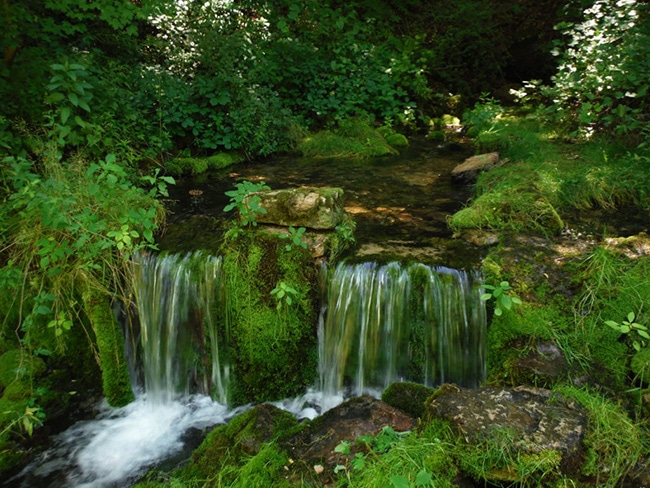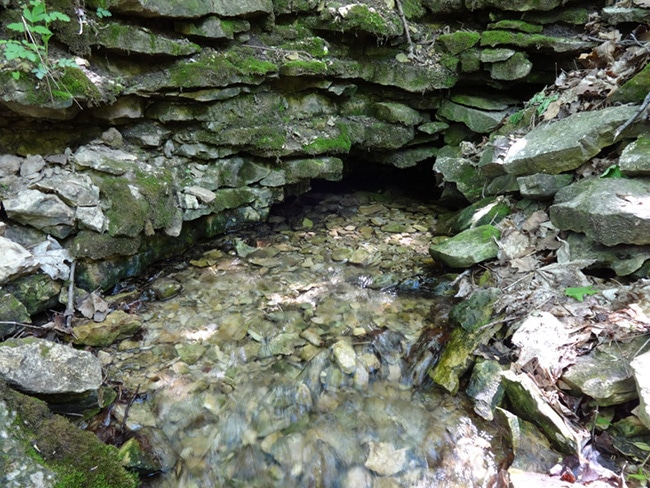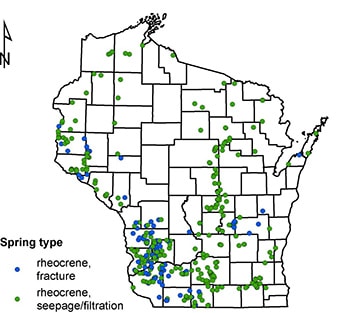Thermal imaging to characterize the spatial distribution of temperature in freshwater springs
Overview: During the Wisconsin Springs Gateway project, we will explore how local variations in topography, surficial geology, and bedrock geology influence the spatial distribution of temperature in freshwater springs. Cold and stable temperatures are often cited as important environmental conditions in springs, affecting species richness and diversity (Gaffield et al., 2005; Knight and Notestein, 2008; von Fumetti et al., 2017). However, there is currently a lack of information on the spatial distribution of temperature in springs and how distributions vary among springs of differing types. Using an infrared camera that is suspended above a spring pool, there are opportunities to examine the thermal properties of springs in a relatively quick and noninvasive manner. Our primary goal is to collect detailed temperature data sets from springs in a variety of geologic settings across Wisconsin. In the process, students will use thermal imaging infrared cameras and Trimble Juno® handheld data collectors, as well as learn a variety of flow gaging techniques and water sampling methods.

A spring emerging from fractured limestone in southwestern Wisconsin
When: June 1 – July 3, 2020
Where: Beloit, Wisconsin (introduction and lab work) and field sites across Wisconsin (field work).
Who: Three rising sophomores, one rising senior, and project leader Dr. Sue Swanson (Beloit College, swansons@beloit.edu)
Prerequisites and Recommended Courses: There are no specific coursework prerequisites for the three rising sophomores, but the project is ideally suited for students with interests in hydrogeology, fluvial geomorphology, water chemistry, and aquatic ecology.
The rising senior should have completed two or more of the following courses: hydrogeology, geomorphology, sedimentology, geochemistry, geographic information systems. The student will also serve as a peer mentor, so they should have prior experience as a teaching assistant or tutor.
All students applying for this project should enjoy being outside and walking through streams and wetlands in boots or waders (will be provided). We will also work in forested environments. All of these environments tend to have biting insects, such as mosquitos or ticks. Individuals should be open to using insect repellent and should be capable of carrying field equipment over uneven ground.
Expectations and Obligations:
All students
• Participation in all project-related work during the summer (June 1 – July 3, 2020).
• Commitment to work collaboratively in an environment of mutual respect.
Rising sophomores
• Write a team abstract and present a poster at the American Water Resources Association – Wisconsin Section annual meeting in spring 2021 (all expenses covered).
Rising senior
• Follow up data analysis at home institution and regular conference call with project director throughout academic year.
• Write an abstract and present a poster at the American Water Resources Association – Wisconsin Section annual meeting in spring 2021 (all expenses covered).
• Write a short contribution (4-6 pages text + figures) to be published in the Proceedings of the Keck Geology Consortium 2021 Volume (first draft due Mid-February).
• Expected but not required: Use this work for the completion of a senior thesis (or equivalent) at your home institution.
PROJECT DESCRIPTION
Thermal imaging holds potential for characterizing the spatial distribution of temperature in freshwater springs. Cold and stable temperatures are often cited as important environmental conditions in springs, affecting species richness and diversity (Gaffield et al., 2005; Knight and Notestein, 2008, von Fumetti et al., 2017). However, there is currently a lack of information on the spatial distribution of temperatures in springs and how distributions vary among springs of differing types, such as seepage/filtration springs or fracture springs (Figures 1 and 2). Using an infrared camera that is suspended above a spring pool, there are opportunities to examine the temperature distribution of springs in a relatively quick and noninvasive manner. Ground-based thermal imaging has been shown to differentiate between diffuse and focused groundwater discharge (Cardenas et al., 2008; Deitchman and Loheide, 2009) and initial testing of the use of a hand-held thermal camera to characterize springs of differing types in Wisconsin shows a distinction between seepage/filtration springs and fracture springs. Seepage/filtration springs display a right-skewed or bimodal distribution and higher standard deviation in temperature, whereas fracture springs display a bell-curve distribution and lower standard deviation (Kopas and Swanson, 2016).

Figure 1: Example of a seepage/filtration rheocrene spring.

Figure 2: Example of a fracture rheocrene spring.
The recently completed inventory of springs in Wisconsin mapped and characterized 415 large springs, or springs discharging approximately 0.25 cfs or more at the time of surveying (Figure 3) (Swanson et al., in review). Using this database, our primary goal will be to collect detailed temperature data sets from spring sites across Wisconsin. We will measure the temperature distribution within spring pools at a minimum of 20 rheocrenes (springs discharging to streams) selected from the Wisconsin springs inventory, ten with seepage/filtration morphologies and ten with fracture morphologies. Imagery will be collected in mid-July, when differences in spring pool and groundwater temperatures are at a maximum.
To complement the thermal data and further characterize spring pool characteristics that can influence aquatic habitat, field water quality indicators such as pH, specific conductance, and dissolved oxygen (DO), will also be measured and mapped across each spring pool. Following the characterization of the spatial distribution of temperature and each water quality indicator for each spring type, we will compare summary statistics, such as variance or skewness, to the spring flux (ft/s), defined as spring flow (ft3/s) divided by spring orifice area (ft2), for each spring. Spring flux provides a meaningful way to distinguish between groundwater discharge features dominated by discrete versus diffuse groundwater flow. The median fluxes for fracture or contact springs, seepage-filtration springs, and ponds in Wisconsin are 4×10-2 ft/s, 6×10-3 ft/s, and 1×10-5 ft/s, respectively (Swanson et al., in review). Robust relationships between temperature or other water quality summary statistics and spring flux, which is more easily measured, would then allow the use of spring flux as a predictor of the spatial distribution of temperature and water quality in springs of differing types.

Figure 3: Distribution and types of springs in Wisconsin (Swanson et al., in review).
Potential Student Projects: Students will work as a team throughout the project to organize and calibrate field equipment, image the distribution of spring pool temperatures, and measure and map water quality within the spring pools. After returning to campus, the three rising sophomores will work collaboratively on the thermal data set, while the rising senior (and peer mentor) will primarily work on the geochemical data set.
1. Thermal characterization of spring pools of differing spring types. The three rising sophomores will work together on the statistical analysis of the temperature data. This will involve downloading and organizing the thermal data from all of the field sites (>20), tabulating the thermal data and calculating summary statistics, and performing basic statistical tests, such an F-test of equality of variances. If there is time, we may also use spatial statistics (Moran’s I) to describe the degree to which temperature values similar in magnitude are clustered within spring pools of differing spring types.
2. Geochemical characterization of spring pools of differing spring types. The rising senior (and peer mentor) will take the lead on the statistical and spatial analysis of the water chemistry data. Similar to the temperature data, this will involve downloading and organizing the pH, conductivity, and DO data for all of the field sites (>20), tabulating data, calculating summary statistics, and performing basic statistical tests. However, because water quality data will be collected as point data, they must be processed before performing spatial statistics. During the following academic year, the rising senior will create isopleth maps of the spring pool parameters (using ArcGIS) and perform the subsequent spatial statistics as part of their senior thesis research.
PROJECT LOGISTICS
Students will arrive in Beloit, Wisconsin on June 1. The first week will be spent in the classrooms and laboratories at Beloit College, where students will be introduced to the project through a series of lectures, discussions, and local field excursions to springs within 1-2 hours driving distance. We will also discuss field safety and strategies for effective communication in the field, practice field methods, and gather equipment for field work. During this time, students will be housed on campus in Beloit College dorm rooms that are dedicated to the students for the entire 5-week program. The next two-and-a-half weeks will be spent mostly in the field, although we will return to Beloit on weekends. While in the field, the group will camp. All camping gear (tents, cooking gear) will be provided. Gear such as sleeping bags, sleeping pads, knee boots, and waders will be available for loan. The final week-and-a-half will include data analysis and preparation of our abstract and poster. Students depart Beloit on July 3.
PROFESSIONAL DEVELOPMENT
Conducting a research project at an early career stage is not only a résumé-builder, but helps to develop many skills that are applicable after the summer is over. Working and living together in the field, collaboratively completing a project from start to finish, and starting to develop a network of friends and colleagues all build resiliency, capabilities, and cognitive abilities. This Gateway Keck project offers these experiences in a supportive yet challenging environment. Students will work on real scientific questions, using standard and state-of-the art field and lab equipment; they will also receive training in science communication, including informal interactions with the public in the field, and more formal methods of presenting information such as lightning talks and giving better, more engaging research presentations.
References
Cardenas, M.B., Harvey, J.W., Packman, A.I., and Scott, D.T. (2008) Ground-based thermography of fluvial systems at low and high discharge reveals potential complex thermal heterogeneity driven by flow variation and bioroughness: Hydrological Processes, Vol. 22, doi: 10.1002/hyp.6932.
Deitchman, R.S., and Loheide II, S.P. (2009) Ground-based thermal imaging of groundwater flow processes at the seepage face, Geophysical Research Letters, Vol. 36, doi: 10.1029/2009GL038103.
Gaffield, S.J., Potter, K.W., and Wang, L. (2005) Predicting the summer temperature of small streams in southwestern Wisconsin: Journal of the American Water Resources Union, Vol. 41, doi: 10.1111/j.1752-1688.2005.tb03714.x.
Knight, R.L., Notestein, S.K. (2008) Springs as Ecosystems, in Summary and Synthesis of the Available Literature on the Effects of Nutrients on Spring Organisms and Systems: University of Florida Water Institute, p.1-46.
Kopas, D.C. and Swanson, S.K. (2016) The Application of Handheld Infrared Thermography in the Characterization of Springs in Southern Wisconsin, Geological Society of America Abstracts with Programs, Vol. 48, No. 7, Abstract 78-1.
Loheide, S.P., II and Gorelick, S.M. (2006) Quantifying stream-aquifer interactions through analysis of remotely sensed thermographic profiles and in-situ temperature histories: Environmental Science and Technology, Vol. 40, No. 10, p. 3336–3341.
Swanson, S.K., Graham, G.G., Hart, D.J. (in review) An inventory of springs in Wisconsin, WGNHS Bulletin.
Von Fumetti, S., Bieri-Wigger, F., and Nagel, P., 2017, Temperature variability and its influence on macroinvertebrate assemblages of alpine springs: Ecohydrology, Vol. 10, Issue 7, doi: 10.1002/eco.1878.
